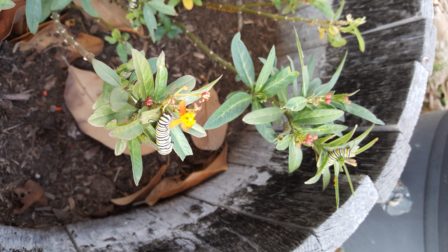Growing Plants that Boast Medicinal Benefits
By Violet Green

Milkweed plants serve needs for people and other creatures of the earth.
Yep, I’m a plant nerd! I’ve spent most of my life dabbling in gardening (on the East Coast, then the Midwest, and now here in Southern CA) and playing with plants. I’m happiest with soil under my fingernails and on the bottoms of my feet.
My current home garden boasts medicinal herbs, a vegetable garden, and ornamental plants that all help to keep the wildlife nurtured. From the hummingbirds and finches to the butterflies, I try to keep a variety of plants and flowers from one end of the property to the other, so they’ve got a clear path of abundant flowers. It’s also fun to discover what’s newly blooming and to detect new scents wafting in our windows. One of my favorite flowering plants is milkweed, with its bouquets of orange, red, red-orange, and yellow flowers. The showy blooms make me smile and I know the hummers and all butterflies love to drink from them.
Even though I’ve been living in San Diego for 22 years now, only in the past 10 years, did I learn about milkweed and how the monarch butterflies depend on it. Milkweed is the only caterpillar host plant used by monarch butterflies, which means that they must have these plants in order to successfully reproduce and sustain their population. They also count on the nectar to energize their bodies as they migrate from location to location. Lucky for those of us here in San Diego, milkweed is easy to grow, drought tolerant, and recovers quickly after each wave of caterpillars.
According to the National Wildlife Federation’s website, there are 12 native milkweed plants in the United States that are suitable for monarch grazing and habitat. You can easily find plants at local nurseries or seeds online. Most home garden centers carry Asclepias tuberosa and label it with the common name of as Butterfly Weed. They are one of the easiest plants to grow and are self-maintaining. Just remember, when the caterpillars hatch they are very hungry and will eat all of the leaves and flowers on your plant – until there’s nothing left but nubs of branches. Don’t despair, and don’t compost your plant, it will recover within a couple of weeks and grow leafy and strong to sustain the next wave of hungry caterpillars.
Asclepias tuberosa is also a medicinal plant that’s been used traditionally (by native peoples) for coughs and sore throats and also for diarrhea, and even in larger doses as an emetic to induce vomiting. A tea made from the root of Asclepias tuberosa, also known as pleurisy root, has a specific affinity for the lungs, reduces inflammation (thus helping bronchitis and pleurisy), and aids in decongestion by causing a mild expectorating action. It can also help to relieve issues with breathing difficulty as inflammation is reduced and its antispasmodic properties can help to calm muscles in the chest area.
Use of pleurisy root is contraindicated during pregnancy. Please remember any information relayed here is for informational purposes only and not intended as medical advice. Check with a qualified herbalist for dosage details or your healthcare practitioner before self-administering herbs.
Category: Health & Fitness, Life Style







